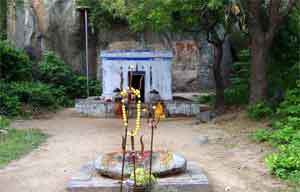
Origin name of the fort
The actual name of Gingee is Sengiri meaning perhaps the Red Hill in Tamil that has got corrupted into Gingee. Some say that the name Sengiri has originated from 'Sanjeevi' the hill mentioned in Ramayana from where Hanuman gets the life saving herb, the Sanjeevini Booti for Lakshamana when he is lying unconscious during the war between Rama and Ravana. The Sanjeevi herb is the panacea of Indian mythology. It has been explained as the combination of two roots, Sam (pleasure) and Ji (life). The name has also been traced to Singavaram the neighbouring Vaishnavite shrine, whose lord is supposed to be the guardian deity of the place.
The local tradition has another explanation to offer. The legend runs that seven virgin sisters once lived here and one of them was known as Senjiamman. Their modesty was threatened with the possibility of violation of their chastity. Even though a valiant man named Thadikara Virappan rescued them from danger, they could not survive the insult and so committed suicide. Their spirits are even now believed to be haunting the place and considered the genii loci. Each of the sisters has got her own little shrine still existing and attracts votaries from the neighbourhood. It is very probable that Senjiamman who is worshipped on top of one of the hills gave her name to the particular hill and this afterwards came to be the common designation of the whole circle of hills and villages below.
Another of the sisters, Kamalakanniamman, has a shrine dedicated to her at the base of Rajgiri, which, on certain days in the year attracts a great number of worshippers. This hill was originally known after the goddess as Kamalagiri. Gingee also had an earlier name known as Krishnapura. This name was possibly given to it by its first ruling dynasty that were of shepherd class and whose tutelary deity was Lord Krishna. However, it is possible that it might have received the name from its powerful ruler, Krishnappa Nayak.
The Bijapur Nawabs who held the fort from about 1660-77 A.D. called it Badshabad, while the Marathas who succeeded them called it Chandry or Chindy. The Mughals, on their capture of the fort in 1698 A.D. named it Nasrat Gaddah in honour of Nawab Zulfiquar Khan Nasrat Jang, the commander-in-chief of the besieging army. Later, the English and the French called it Gingee or Jinji. The early Madras records of the English give the spelling Chingee or Chengey. Whatever might be the name by which it might have been known in different epochs, it has retained the name Gingee.
The chief source for the first two hundred years of the history of the place is the "Complete History of the Carnatic Kings" among the Mackenzie manuscripts. One Narayan, who claimed to be a descendant of the Ananda Kon Clan of Gingee, compiled it, after a consultation with numerous authorities, both Hindu and Muhammadan. According to Narayan, Gingee became a fortified place only about 1200 A.D. Ananda Kon of the shepherd community, accidentally found a treasure in one of the cavities of the Western hill while grazing his sheep. Making himself the head of a small band of warriors, he defeated the petty rulers of the neighbouring villages and built a small fortress on Kamalagiri which he renamed Anandagiri after himself.
The Kon dynasty ruled Gingee from 1190 to 1330 A.D. This shepherd race was then superseded by the chief of a neighbouring place called Kobilingan, who belonged to the kurumba caste and ascended the throne of Gingee. He was a feudatory of the powerful Cholas. This way Gingee came into the hands of various ruling dynasties of South India starting from the Cholas.
C K Gariyali IAS
Source : Chennaionline.com